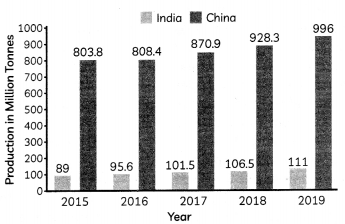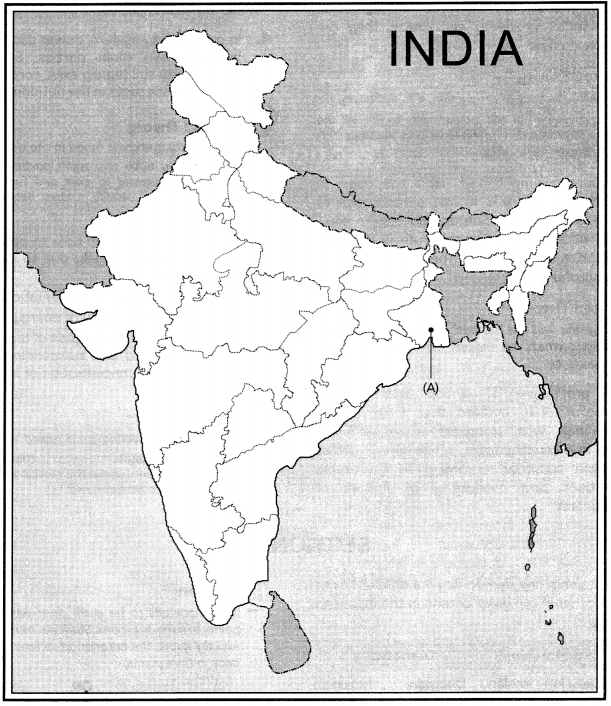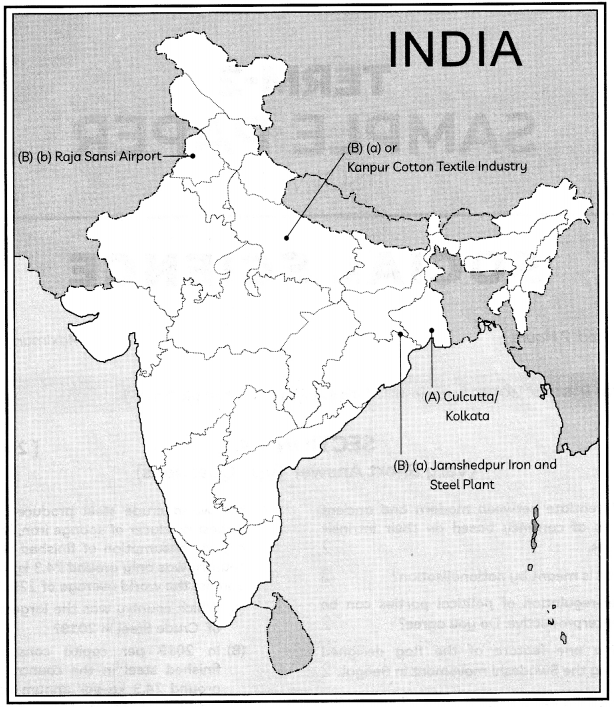Students can access the CBSE Sample Papers for Class 10 Social Science with Solutions and marking scheme Term 2 Set 3 will help students in understanding the difficulty level of the exam.
CBSE Sample Papers for Class 10 Social Science Term 2 Set 3 with Solutions
Time Allowed: 2 Hours
Maximum Marks: 40
General Instructions:
- This Question paper is divided into five sections-Section A, B, C, D and E.
- All questions are compulsory.
- Section-A: Question no. 1 to 5 are very short answer type questions of 2 marks each. Answer to each question should not exceed 40 words.
- Section-B: Question no. 6 to 8 are short answer type questions, carrying 3 marks each. Answer to each question should not exceed 80 words.
- Section-C: Question no. 9 and 10 are long answer type questions, carrying 5 marks each. Answer to each question should not exceed 120 words.
- Section-D: Question no. 11 and 12 are Case Based questions.
- Section-E: Question no. 13 is map based, carrying 3 marks with two parts, 13.1 from History (1 mark) and 13.2 from Geography (2 marks).
- There is no overall choice in the question paper. However, an internal choice has been provided in a few questions. Only one of the choices in such questions have to be attempted.
- In addition to this, separate instructions are given with each section and question, wherever necessary.
SECTION-A [2 × 5 = 10]
(Very Short Answer Type Questions)
Question 1.
Industrial locations are complex in nature. Support the given statement with two points. (2)
Answer:
Industrial locations are selected after keeping multiple factors in mind. Each factor must be satisfied before finally choosing one Location. These factors include easy availability of raw material labour, capital, power, transportation and market proximity etc. Hence, they are complex to find,
Related Theory:
To reduce the cost of production. ir is necessary for the businessmen or the industrialists ta find all the factors of production at the Least cost possible. This will increase their proflts
Question 2.
Satyagraha was a new concept introduced by Gandhi. What is the essence of this concept? (2)
Answer:
Satyagraha emphasised upon the need to search for the truth. It was a realisation of the power of truth. Satyagraha is pure soul- force. According to Gandhi, truth is the very substance of the soul. The force is called satyagraha.
Related Theory:
Satyagraha was the method used in multiple mass agitations which led Indians closer towards their Independence.
Question 3.
How has the production of goods and services changed over time? (2)
Answer:
The production of goods and services has completely evolved over time. Earlier, production was organised within different cities in a country, today it has spread across multiple countries according to favourable conditions and availability of factors of production.
Related Theory:
Until the middle of the twentieth century, production was largely organised within countries. Only raw material, food stuff and finished products crossed the boundaries of a country.
Question 4.
How many parties are permitted to legally exist in a two party system? (2)
Answer:
In a two party system, power usually changes between two main parties. Several other parties may still legally exist, contest elections and win a few seats in the national legislatures.
Related Theory:
A two party system is found in the UK and the USA. They usually have two main parties but multiple parties are allowed to exist and function in their capacity. Power usually rotates between the two parties.
Question 5.
Study the data given on production of steel in India and China in the past few years and answer the questions that follow:

(A) Why has the production of steel not increased in India when compared to China? (1)
Answer:
India has not been able to perform to our full potential largely due to the following reasons:
- Lower productivity of labour
- Irregular supply of energy
(B) Which region in India has the highest concentration of Iron and Steel industries? (1)
Answer:
The Chotanagpur region of India which lies in Jharkhand and surrounding states has the highest concentration of Iron and Steel industries.
Caution
The key to answering data based questions is to focus upon the keywords asked in the question. They direct the students about the perspective with which the data has to be examined.
SECTION -B [3 × 3 = 9]
(Short Answer Type Questions)
Question 6.
Differentiate between dictatorships and democracy on the basis of economic development and decision making processes.
or
Enumerate a few reasons that make representative democracies necessary for large societies. (3)
Answer:
Dictatorship and democracy are different from each other in the given criteria in the following ways:
| Dictatorships | Democracy |
| 1. Decision making is quick but unpopular and often selfish. | 1. Decision making is slow but widely accepted, popular and to the benefit of the people |
| 2. Economic development is slightly better because of direct policies and no conflict of interests. | 2. Economic development is slightly Less because of multiple conflict of interests among the societies. |
Caution
It is important to be stark clear while mentioning points in such questions. Students must make sure to exactly quote the criterion of differentiation atleast once in their points.
OR
Representative democracies are important for large societies because:
- Large societies need an important agency to gather different views on various issues and to present these to the government. These representatives form that agency.
- Large societies also require a mechanism and institutions to support or restrain the government, make policies, execute or oppose them because if they were done directly, it would prove to be chaotic. Repesentative democracy is the solution to this requirement
- Representative democracy is important for large democracies to ensure that brute force or muscle power doesn’t become authoritative and assume control of the country.
Question 7.
Besides banks, the other major source of credit in rural areas is the cooperative societies. How do these cooperative societies function? (3)
Answer:
The cooperative societies function in the following ways:
- Cooperatives are formed of many members and can be created according to specific interests.
- Cooperatives accept deposits from its members. With these deposits as collateral, the Cooperative obtains a large loan from the bank.
- The funds loaned from the bank are thereafter used to provide loans to its members. Once these loans are repaid, another round of lending takes place. This is how cooperative societies function.
Question 8.
Pipelines are an important aLternative form of transportation to transport Liquids and gases. Do you agree? Support your stand. (3)
Answer:
Yes, pipelines are very effective means of transportation for liquids, solid slurries and gas. This can be asserted in the following ways:
- Pipelines do not require a lot of maintenance once laid down.
- Pipelines do not lead to energy or product leakage. They cause very little trans-shipment delays.
- Pipelines also save liquids and gas from evaporating or sublimation because they use covered pipes.
Caution
Questions which involve Yes or No as their answers must always be answered incorporating the points to support the student’s stand. They should be backed up by example and important points.
SECTION – C [5 × 2 = 10]
(Long Answer Type Questions)
Question 9.
Why was the Quit India Movement launched? Throw some light on the participants and main incidents.
OR
Enlist the ways in which credit helps in the development of agriculture and the agriculturists. (5)
Answer:
The Quit India movement was launched as a consequence of the failure of Cripps Mission. Leaders had hoped for honest devolution of powers after the World War II ended.
- When no such devolution took place, Mahatma Gandhi was severely disappointed and launched the ultimate national movement called the Quit India movement
- The Quit India movement was a culmination of the decades-long national independence movement.
- Gandhi delivered a do or die speech on its launching day signalling its significance.
- People observed hartals, and demonstrations and processions were accompanied by singing national songs and slogans.
- The movement was essentially a mass movement and saw participation from thousands of ordinary people, namely students, workers and peasants apart from the revolutionaries.
Women, such as Matangini Hazra in Bengal, Kanaklata Barua in Assam and Rama Devi in Odisha, participated in large numbers.
OR
Credit helps in the development of agriculture and the agriculturists in the following ways:
- The credit helps the farmers and farm labourers to meet the ongoing expenses of their farming activities and production.
- Credit allows them to purchase raw material like HYV seeds, fertilisers and other innovative equipment which they can use to further enhance their production even more.
- Credit also helps the farmers in arranging capital for irrigational facilities and investing in more advanced technologies.
- Farmers generally borrow money before harvesting and sowing seasons. Hence the credit also helps them post harvest.
- Credit also helps farmers by assisting them in their personal daily expenses, thus adding to their lifestyle.
Question 10.
It is important for the Indian textile manufacturers to improve the production of our domestic weaving sector instead of exporting yarn in large quantities. Validate the given statement.
OR
Industrialised countries can afford democracy but the poor need dictatorship to become rich. Do you agree? Validate your stand. (5)
Answer:
It is extremely important for Indian textile manufacturers to improve our domestic weaving sector instead of exporting premium quality yarn in large quantities.
False
- Most of the production is in fragmented small units, which cater to the local market.
- The yarn produced in the country is of extremely high quality. This is a huge mismatch.
- The yarn has to be exported to various foreign countries. To use this amazing quality of yarn, our domestic weaving sector needs to be improved technologically.
- Exporting raw materials earns lesser revenue than exporting finished goods.
- New equipment along with some marketing and incentivising are required to help save the sector.
OR
No, I don’t agree with the given statement. This can be argued in the following ways:
- Democracies or dictatorships are not synonymous with any form of development. They are just forms of government They can only create a conducive atmosphere for development.
- Economic Development needs structural reforms to the benefit of the citizens keeping the interests of all the communities in mind. Dictatorships do not show a good performance in that area.
- Dictatorships only have slightly better rates of economic growth than Democracies. This does not translate into the assertion that dictatorships guarantee economic growth.
- Democracies ensure that the disadvantaged classes are protected and encouraged.
- Thus, this form of government is ideal for the poor classes to develop.
Caution:
Questions, where the student’s opinions are asked, can be answered either in a yes or no depending upon the choice of the student. It is important to however validate your stand and present examples to support it
SECTION-D [4 × 2 = 8]
(Case Based Questions)
Question 11.
Read the following sources and answer the questions that follow:
He felt the movement was turning violent in many places and satyagrahis needed to be properly trained before they would be ready for mass struggles. Within the Congress, some leaders were by now tired of mass struggles and wanted to participate in elections to the provincial councils that had been set up by the Government of India Act of 1919. They felt that it was important to oppose British policies within the councils, argue for reform and also demonstrate that these councils were not truly democratic. C. R. Das and Motilal Nehru formed the Swaraj Party within the Congress to argue for a return to council politics. But younger leaders like Jawaharlal Nehru and Subhas Chandra Bose pressed for more radical mass agitation and for full independence. In such a situation of internal debate and dissension two factors again shaped Indian politics towards the late 1920s. The first was the effect of the worldwide economic depression. Agricultural prices began to fall from 1926 and collapsed after 1930.
(A) Which movement is mentioned in the given source? Why did Mahatma Gandhi call it off? (1)
Answer:
The Non-Cooperation movement has been mentioned in the given source. Mahatma Gandhi called off the Non-Cooperation movement because he felt it was becoming very violent after the Chauri Chaura incident.
Caution:
Each movement was called off/on or relaunched for distinctive reasons and hence must be learned for students to be able to eliminate alternative options.
(B) Why were the leaders unhappy with the establishment of provincial councils by the Government of India act, 1919? (2)
Answer:
The leaders were very unhappy with the establishment of provincial councils by the Government of India act, 1919 because:
- Not enough power was given to Indian representatives through the reforms.
- Councils were not democratic in nature.
(C) Why did Gandhi feel that Satyagrahis lacked training? (1)
Answer:
Gandhi felt Satyagrahis lacked training because they were losing patience and turning violent thereby defeating the entire purpose of the movement
Related Theory:
Satyagrahis were told to be patient and not resort to violence in any case. They were encouraged to be self-reliant If they were resorting to violence, it meant they were not yet trained completely.
Question 12.
Read the source given below and answer the questions that follow:
We can understand the necessity of political parties by imagining a situation without parties. Every candidate in the elections will be independent. So no one will be able to make any promises to the people about any major policy changes. The government may be formed, but its utility will remain ever uncertain. Elected representatives will be accountable to their constituency for what they do in the locality. But no one will be responsible for how the country will be run. We can also think about it by looking at the non-party based elections to the panchayat in many states. Although, the parties do not contest formally, it is generally noticed that the village gets split into more than one faction, each of which puts up a ‘panel’ of its candidates. This is exactly what the party does. That is the reason we find political parties in almost all countries of the world, whether these countries are big or small, old or new, developed or developing.
(A) Define the term “Independent Candidate”. (1)
Answer:
Independent candidates do not belong to any political party. They follow their own values and work for their own specific ideologies.
Caution:
Definitions should be extremely specific and precise.
(B) What do you think would be the situation of a political system without any political parties? (2)
Answer:
In a system without political parties, no public opinion on any political, social or economic issue would be formed. People would not be able to develop any awareness regarding democracy and rights. Independent Candidates would never be able to safeguard the interests of every community.
(C) Do you agree that a government formed of independent candidates will be unstable? (1)
Answer:
A government formed of independent candidates will definitely be unstable because there will be no cohesion between different leaders, their ideas and their methods of governing. Hence, it would be very temporary.
SECTION -E [1 × 3 = 3]
(Map Skill Based Questions)
Question 13.
(A) On the given outline Political Map of India, identify the place marked as A with the help of following information and write its correct name on the line marked near it.
(a) A session of the Indian National Congress was held here in September 1920. (1)
Answer:
Culcutta/Kolkata
(B) On the same given map of India, locate the following:
(a) Jamshedpur Iron and Steel Plant
OR
Kanpur Cotton Textile Industry (1)
(b) Raja Sansi Airport (1)

Answer:
(a) Jamshedpur Iron and Steel Plant
OR
Kanpur Cotton Textile Industry
(b) Raja Sansi Airport
